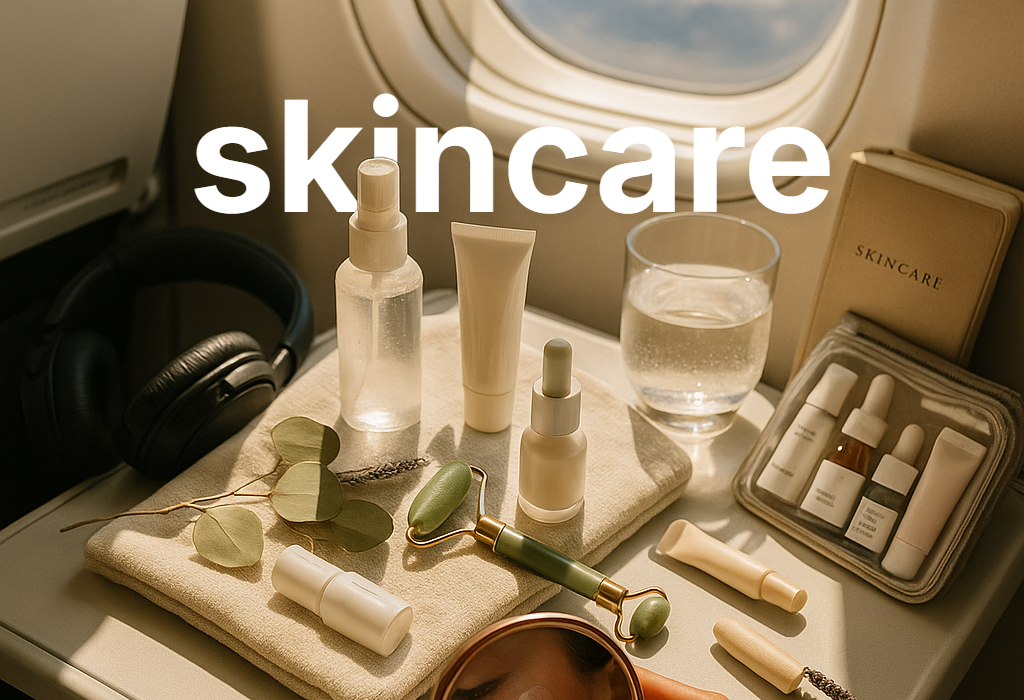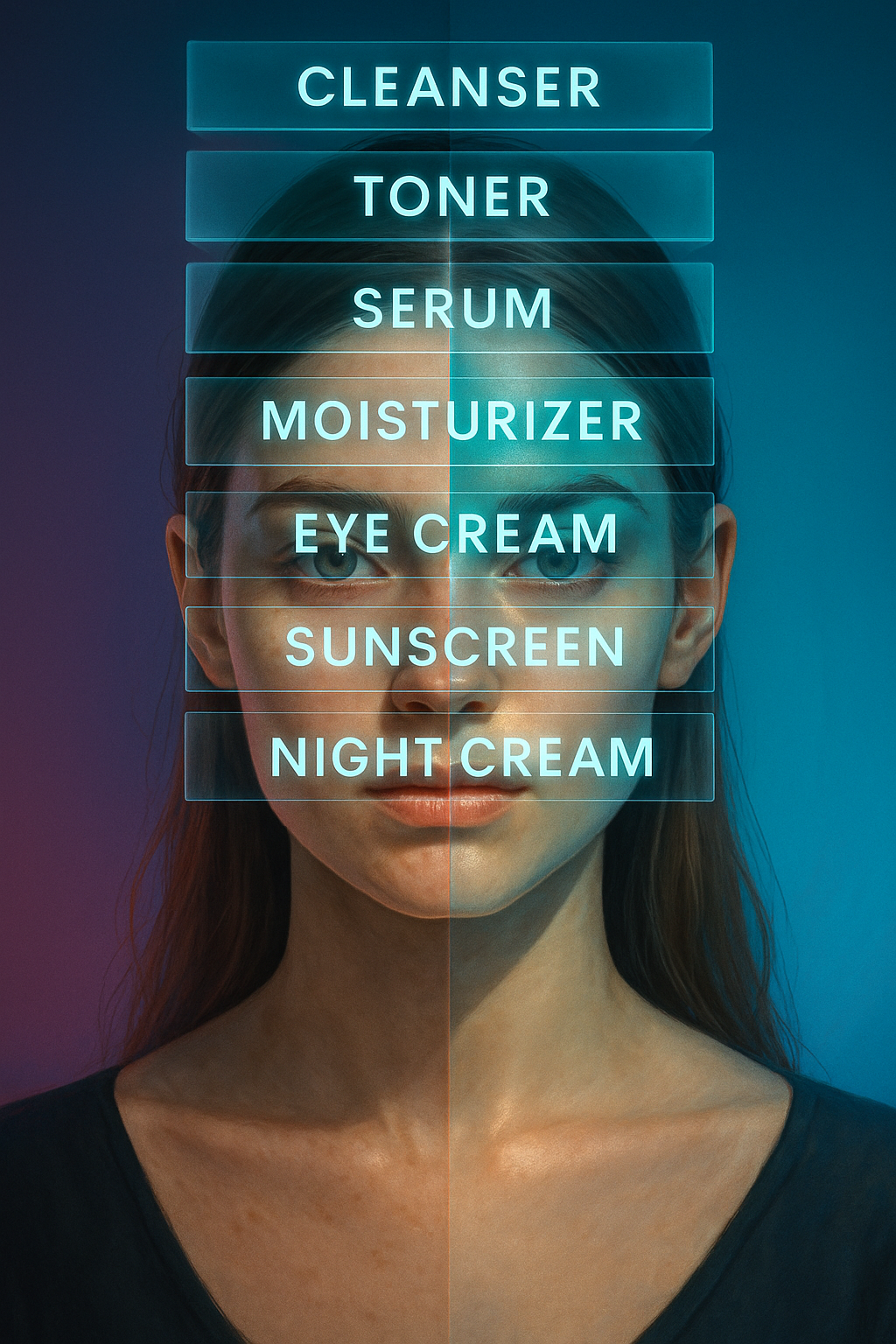Why Airport Skincare Is Important
Flying exposes your skin to extreme dryness, cabin pressure, and elevated UV levels. Most airplane cabins have humidity below 20 %, which sucks moisture from your skin and leaves it dry, tight, and dull. UV rays can penetrate airplane windows, increasing sun exposure even at cruising altitude. Add fatigue, stress, and reused air, and you’ve got the perfect environment for dehydrated, irritated skin. Caring for your skin at all stages of travel helps preserve hydration, reduce inflammation, and arrive looking refreshed.
Step 1: Before You Fly – Prep That Skin
🧖♀️ The Night Before
- Use a hydrating sheet mask or overnight cream rich in hyaluronic acid or glycerin to fortify skin beforehand.
- Apply under‑eye serum and a vitamin‑C treatment or hydrating serum the morning of your flight to support skin resilience.
Morning of Departure
- Cleanse thoroughly with a gentle, non‑foaming cleanser.
- Layer hydration: toner → hydrating serum → moisturizer → sunscreen SPF 30+. This multi‑layer strategy locks in moisture and primes your skin barrier.
- Apply a broad‑spectrum sunscreen—especially if you have a window seat. UV exposure at altitude can equal tanning-bed intensity in 20 minutes.
Step 2: Pack Smart – Carry‑On Essentials
Pack wisely in your carry‑on:
- Micellar wipes or travel cleansing pads for water‑free cleansing.
- A mini hyaluronic acid or squalane serum that can serve dual‑purpose AM/PM.
- Lightweight, non‑comedogenic moisturizer with ceramides or glycerin.
- Hydrocolloid pimple patches to treat breakouts discreetly.
- Lip balm and hand cream to combat dryness beyond your face.
- Hypochlorous acid mist or calming spray for sanitizing and soothing.
Choose double‑duty items: like tinted SPF or mask + serum combos—to save space and streamline your routine.
Step 3: In-Flight Skin Routine
Gentle Cleansing
- Avoid washing your face with airplane water. Instead, use micellar water or wipes for refresher cleanse. A few sweeps will remove surface oils and refresh skin.
Mask Up (Sheet + Eye Patches)
- Apply a sheet mask or under-eye patches (with hyaluronic acid or niacinamide) mid-flight. This hydrates and calms skin without frequent touching of the face.
Moisturize Strategically
- Use a rich, non‑comedogenic moisturizer before boarding. Avoid reapplying it mid-flight if you’re concerned about contaminating your hands.
- For long flights, reapply a thin layer every few hours if possible.
Face Mists (With Caution)
- While some warn against misting alone (because dry air may pull moisture out of skin), others endorse hydrating mists with humectants like glycerin or aloe vera—if layered over moisturizer or serum.
- Choose formulas that also disinfect (e.g. hypochlorous acid-based sprays) to avoid breakouts.
Reapply Sunscreen
- Reapply SPF every two hours, including to face, neck, and hands—especially if you’re seated by the window.
Stay Hydrated Inside and Out
- Drink at least 8 oz of water every hour. Avoid alcohol, caffeine, and salty snacks that dehydrate skin.
Move and Stretch
- Get up hourly, stretch legs, rotate feet, or flex toes to boost circulation and reduce fluid retention—especially helpful for puffy or swollen faces.
Step 4: After You Land – Recovery Mode
💧 Cleanse Refresh
- Once you disembark, wash your face with a gentle, detergent-free cleanser to remove accumulated grime, stale cabin air, or salt residue from tears or sweat.
Exfoliate Lightly
- Use a gentle exfoliant (e.g. jojoba or soft beads) to brighten skin and remove dull buildup. Avoid harsh scrubs that could irritate after flight-induced dryness.
Hydrating Mask
- Apply a gel or cream mask infused with antioxidants or vitamins—to replenish lost moisture and glow up your complexion later in your destination.
Facial Massage or Inversion Trick
- Do a quick facial massage using upward, outward strokes or hang your head upside down for 2–3 minutes to encourage lymphatic circulation and boost radiance.
Maintain Your Routine
- Stick to the skincare products you’re used to. Avoid experimenting with new formulas mid-travel to prevent irritation from unfamiliar ingredients or environmental changes.
Reapply SPF
- Don’t skip sunscreen after landing, especially if you’re heading outdoors. UV exposure is still a risk post-flight.
Bonus Tips & Tricks
- Skip heavy makeup on flights. It can dry out skin and clog pores in the low‑humidity cabin environment.
- Avoid face mist misuse. Alone, misting can actually reduce skin moisture if not sealed in by serum or moisturizer.
- Expect occasional maskne, especially during long flights—use spot patches or light moisturizer to preempt breakouts.
- Elevate comfort with wellness tools like gua sha, jade rollers, or travel compression socks to reduce puffiness and refresh circulation.
Quick Summary Table
| Stage | What to Do | Why It Matters |
|---|---|---|
| Pre‑Flight | Mask, serum, sunscreen, hydration layer | Build a hydrated base before stress |
| In‑Flight | Wipes, sheet mask/eye patches, moisturizer, SPF | Protect from dehydrating cabin air |
| Mid‑Flight | Water intake, minimal touching, movement | Hydrate and boost circulation |
| Post‑Flight | Gentle cleanse, exfoliate, mask, massage, routine | Restore glow and reset your skin |
Final Thoughts
Air travel may take a toll on your skin, but with the right preparation, you can arrive at your destination hydrated, healthy, and radiant. Focus on hydration, barrier protection, sunscreen, and minimal contact. Stick to routines that your skin already loves, and layer intelligently before, during, and after the flight.
With this thoughtful approach, you won’t just survive flight face, you’ll land looking fresh, glowing, and ready for anything.






